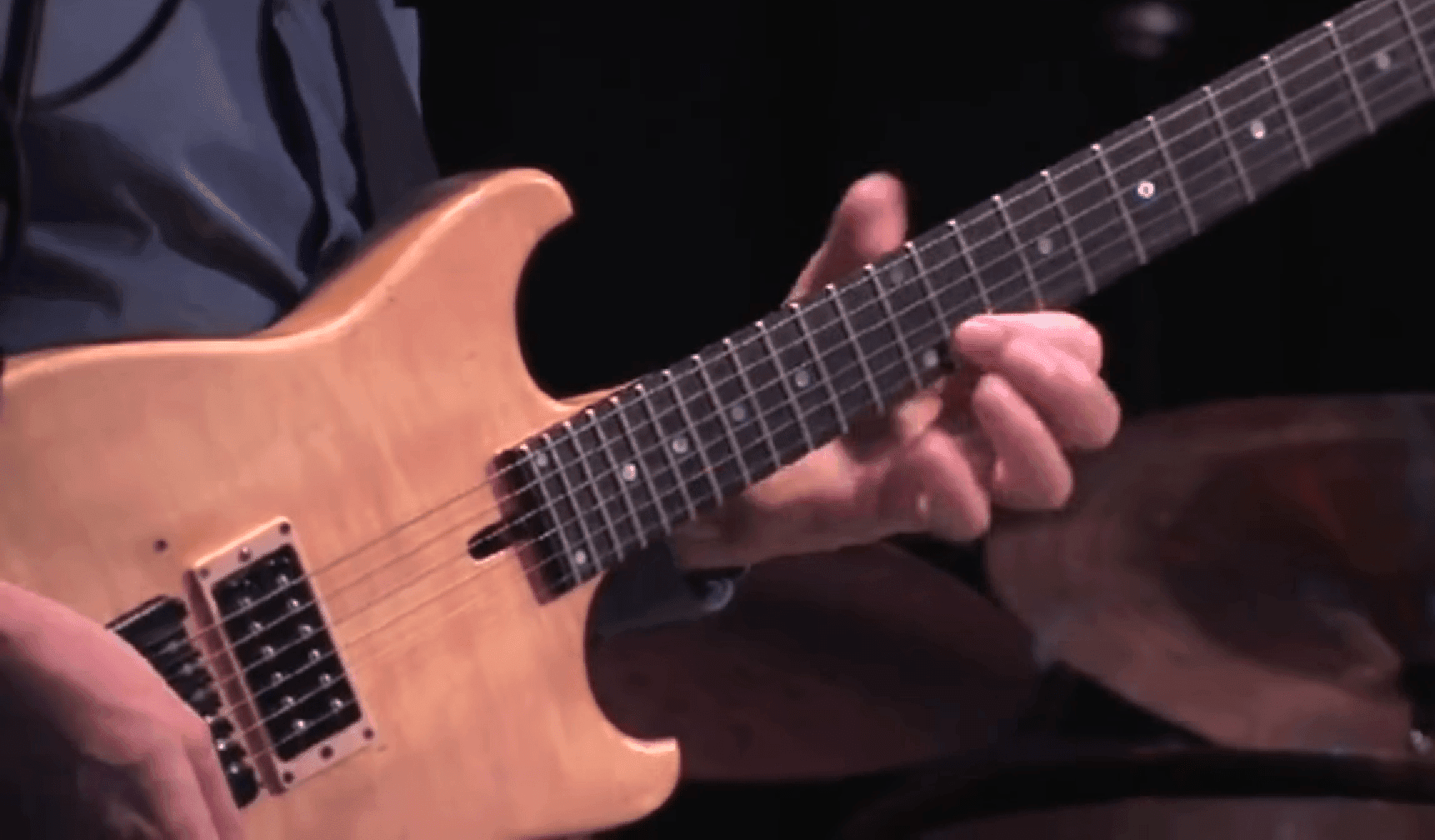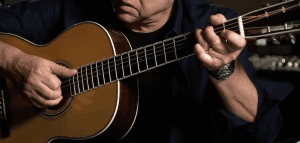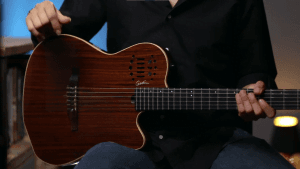Table of Contents
The Legato guitar technique approach focuses on a continuous flow of notes rather than individual picking or plucking. You may make your notes flow more smoothly by employing hammer-ons, pull-offs, and slides.
If you want to add fluidity and expression to your guitar playing, learning legato is a must. It simplifies the process of composing complex melodies and phrases. It’s a fundamental ability that will add depth and impact to your guitar playing.
In this complete guide to the Legato guitar technique, I’ll discuss basic and advanced Legato exercises, as well as things you will need to master this technique.
Have you checked out our list of amazing guitar techniques to elevate your playing to the next level?
Understanding Legato Guitar Technique
Legato guitar technique involves playing notes smoothly and seamlessly by using hammer-ons, pull-offs, and slides, without the need for individual picking or plucking each note. This technique is crucial in guitar playing because it significantly improves the expressiveness and smoothness of melodies, enabling the production of lengthy, sustained notes and complex phrasing.
Compared to picking techniques, legato enables faster execution of complex passages and facilitates smoother transitions between notes. It also reduces fatigue on the picking hand during extended playing sessions.
When compared to tapping, legato provides greater control over note dynamics and allows for more nuances in tone due to the varied finger pressure applied during hammer-ons and pull-offs.
Incorporating legato guitar techniques into your playing style offers numerous benefits, including improved fretting hand dexterity, greater versatility in playing styles, and the ability to create soulful and emotive performances. Additionally, it enables guitarists to add more musical expression and creativity to their playing.
What is Major& Minor Legato? What’s the difference?
In guitar playing, major and minor legato techniques refer to two distinct approaches to creating smooth, connected, and fluid musical phrases.
Major Legato
Major legato is the most common type of legato guitar technique. It is used to play scales and melodies that are primarily in the major key. Major Legato typically uses hammer-ons and pull-offs to connect notes.
Minor Legato
Minor legato is a more advanced type of legato guitar technique. It is used to play scales and melodies that are primarily in the minor key. Minor legato typically uses slides and pull-offs to connect notes.
The main difference between them lies in the scales and chords they are associated with and the emotions they convey. For a better understanding, here is a table below.
| Feature | Major Legato | Minor Legato |
| Primarily used for | Major key scales and melodies | Minor key scales and melodies |
| Technique used | Hammer-ons and pull-offs | Slides and pull-offs |
| Overall sound | Smooth and flowing | Expressive and emotional |
| Difficulty level | Beginner | Intermediate or advanced |
Basic Legato Exercises
Legato’s guitar technique involves playing notes smoothly and connectedly using hammer-ons, pull-offs, and slides. Basic legato exercises are fundamental for developing finger strength, coordination, and control. Hammer-ons and pull-offs are fundamental legato techniques.
- Start with a simple hammer-on exercise. Play a note, then hammer onto the next note on the same string using your fretting hand. Repeat on different strings and positions to develop accuracy and speed.
- Basic pull-off exercise: Begin with two notes played on the same string. Pick the first note and then quickly pull off to sound the lower fretted note.
Incorporating Slides and Bends in Legato Playing
Slides and Bends adds flavor and dynamics to legato playing. Slides involve moving smoothly between two notes by gliding the finger along the string. To execute a slide in legato playing, start by fretting a note and then seamlessly glide your finger up or down the fretboard to another note. This creates a continuous and connected sound.

Bends add expressiveness by pushing or pulling a string to raise or lower its pitch. To perform a bend, press down on a note, typically with your ring or middle finger, and then bend the string to raise the pitch.
Practice Routines for Finger Strength and Dexterity
1. Chromatic finger exercise
Play each finger consecutively on each string, starting from the first fret and moving up to the highest fret possible, then back down.
2. Spider exercise
Place your fingers on adjacent frets across all six strings and then lift and place them down in a sequential pattern, ensuring smooth transitions.
3. Finger independence exercise
Hold down a chord shape and lift one finger at a time, ensuring the other fingers maintain their positions and the strings keep ringing.
Advanced Legato Techniques
Advanced legato techniques build upon the foundation of basic legato exercises. These techniques include trills, vibrato, combining tapping, and incorporating sweeping arpeggios. Mastering these techniques enhances a guitarist’s expressiveness, virtuosity, and overall musicality.
1. Trills and Vibrato in Legato Playing
Trills involve rapidly alternating between two adjacent notes using hammer-ons and pull-offs. Vibrato is the controlled variation of pitch around a central note to add depth and emotion to a sustained note.

To incorporate trills, practice rapidly hammering on and pulling off between two adjacent notes, ensuring evenness and consistency. For vibrato, develop a controlled motion by rocking the fretting finger back and forth while maintaining pitch stability.
2. Combining Tapping into Legato Techniques
Combining tapping with legato allows for even faster and more intricate passages. Tapping involves using the picking hand to “tap” the fretboard, producing notes without using the fretting hand. Incorporate tapping between legato phrases or in conjunction with pull-offs for seamless transitions and enhanced speed.
3. Sweeping Arpeggios and Incorporating Them into Legato
When playing sweeping arpeggios, the pick is “swept” across the strings in a single motion while sequentially playing each note. Incorporating sweeping arpeggios into legato involves executing hammer-ons and pull-offs within the arpeggio pattern to create a continuous flow of notes. Practice arpeggio shapes slowly at first, focusing on clean and synchronized picking and fretting hand movements.
Check out Master 5 Fingerpicking Guitar Techniques here.
Legato Blues Lick technique
A7 Legato Blues Lick
This lick uses a mix of picking and legato techniques to create a musical and interesting sound. Some of the lick uses traditional guitar scale fingering, but it also deviates into less common fingering patterns in places.
You need a strong left hand to play this lick so that all of the notes can be heard. Distortion or overdrive can help the hammer-ons and pull-offs to be heard more clearly, but they should still be audible with a clean guitar tone.
In other words, this lick is challenging to play, but it sounds great when played correctly. Distortion or overdrive can help to make the lick sound more powerful, but it is not necessary.
Pentatonic Legato Lick
The Pentatonic legato lick is more difficult to play because it includes some larger left-hand stretches and slides. It is played over a happy-sounding major chord backing, but it can also be used in a blues context. Experiment with this lick and find major chord progressions that you can use it with.
In other words, this lick is a challenging and versatile lick that can be used in a variety of musical genres. It is a great lick to learn if you want to improve your left-hand stretching and legato technique.
A7 Sweep Picking Circular Lick
The A7 Sweep Picking Circular Lick is a guitar technique that combines the A7 chord with the sweep-picking technique to create a distinctive and fluid sound. This lick is particularly useful in jazz and blues genres, as it allows guitarists to emulate the smooth and melodic qualities often associated with saxophone playing, much like the technique employed by the legendary Charlie Parker.
The A7 chord is a dominant 7th chord and a common component in many jazz and blues progressions. It consists of the notes A, C#, E, and G, and it serves as a foundational element in countless musical compositions.
To execute the A7 Sweep Picking Circular Lick, a guitarist typically employs the sweep-picking technique, which involves using a flat-picking motion across multiple strings while maintaining a consistent downward or upward motion. This technique allows for a seamless and fluid connection between the chord notes, creating a distinctive sound with strong attack and legato-like qualities.
Advanced Practice Exercises for Speed and Precision
- Three-note-per-string legato patterns: Develop precise and fluid legato playing by practicing ascending and descending three-note-per-string patterns across various scales.
- Metronome drills: Set a metronome at a comfortable speed and play legato exercises, gradually increasing the tempo as accuracy and control improve.
- Legato interval jumps: Work on smoothly transitioning between wide intervals (e.g., 5ths, 7ths) using legato techniques.
- Legato chromatic runs: Enhance speed and finger dexterity by practicing chromatic legato runs on different string sets.
Guitar and String Choices
Guitars with low action and smooth fretboards facilitate effortless hammer-ons and pull-offs. A longer sustain can be achieved with solid-body guitars, while semi-hollow or hollow-body guitars add warmth and resonance to legato playing.
As for strings, lighter gauge strings reduce finger fatigue and allow for easier bending and fretting during legato techniques.
Recommended Picks and Accessories
For Legato, thin picks provide better control and responsiveness. Jazz III-style picks or nylon picks are popular choices among legato players. Accessories like finger wraps or tape can aid in preventing finger blisters.
Amplifiers and Effects in Enhancing Legato Sounds
Amplifiers with a clean and transparent tone amplify legato articulations effectively, allowing for clarity and definition. Effects such as reverb and delay add depth and sustain, enhancing the smoothness of legato lines.
Overdrive and distortion pedals provide a dynamic range of legato sounds, making legato solos stand out in the mix. Compressor pedals also help maintain a consistent volume level and sustain during legato playing.
Legato playing is an essential and emotionally charged way to play the guitar. Learning to play legato allows guitarists to play notes together without breaking them up using techniques like hammer-ons, pull-offs, slides, and tapping.
If you put in the time and invest in high-quality instruments, legato can help you craft performances that are both compelling and technically impressive.
FAQs
Here are some tips on how to improve your guitar legato:
➤Practice slowly and focus on accuracy. It’s important to build a solid foundation in legato technique before trying to play fast. Start by practicing simple legato exercises at a slow tempo. Once you can play the exercises accurately, you can gradually increase the tempo.
➤Use a light touch with your left hand. This will help you to avoid muting the strings.
Keep your right hand moving in a continuous motion. This will help you to play the notes smoothly and evenly.
➤Experiment with different hammer-on, pull-off, and slide combinations. This will help you to develop your own unique legato style.
➤Use a metronome to help you keep a steady beat. This is especially important when you’re practicing legato licks at a fast tempo.
Legato can be challenging to learn, but it is not impossible. With practice, you can develop the skills necessary to play legato licks smoothly and effortlessly.
One of the most important things to remember when learning legato is to use a light touch with your left hand. This will help you to avoid muting the strings. You should also keep your right hand moving in a continuous motion. This will help you to play the notes smoothly and evenly.
Legato is an important technique for guitarists to learn because it allows you to play smooth and flowing melodies. It is also a versatile technique that can be used in a variety of musical genres, such as rock, blues, and jazz.
Learning legato can also help you improve your overall guitar-playing skills. For example, legato can help you develop left-hand strength and dexterity. It can also help you to improve your timing and coordination.
If you are serious about improving your guitar-playing skills, then learning legato is a must.
- Budget Classical Guitars Under $700 - February 15, 2025
- How To Set Up A 12-String Guitar Perfectly - September 8, 2023
- Vibrato Techniques: A Comprehensive Guide - September 6, 2023









